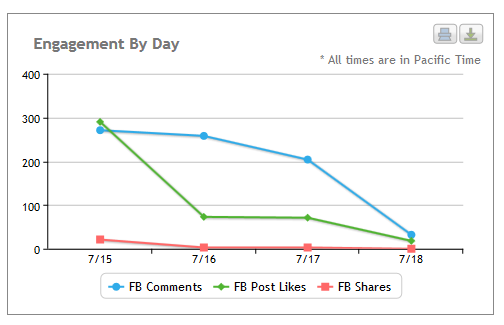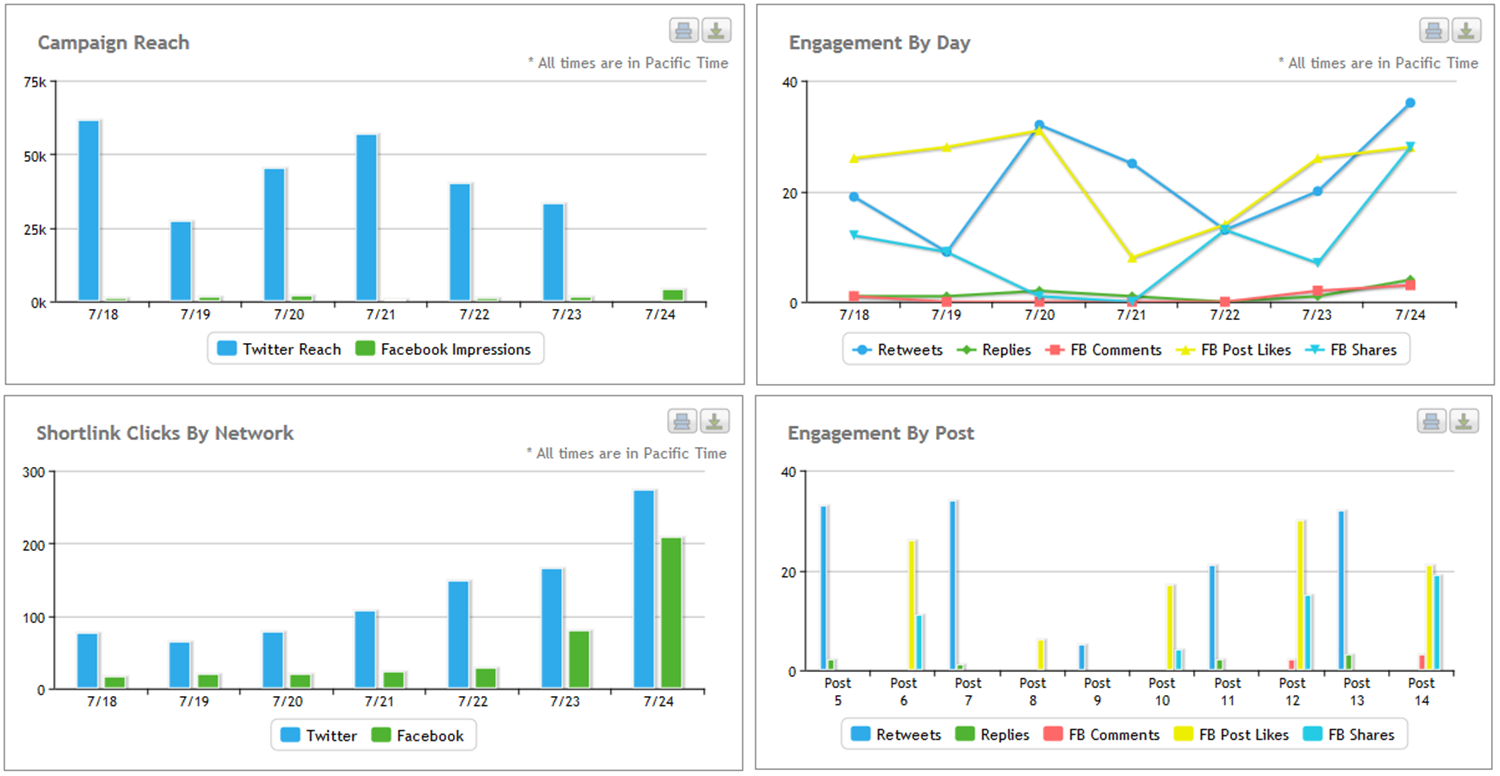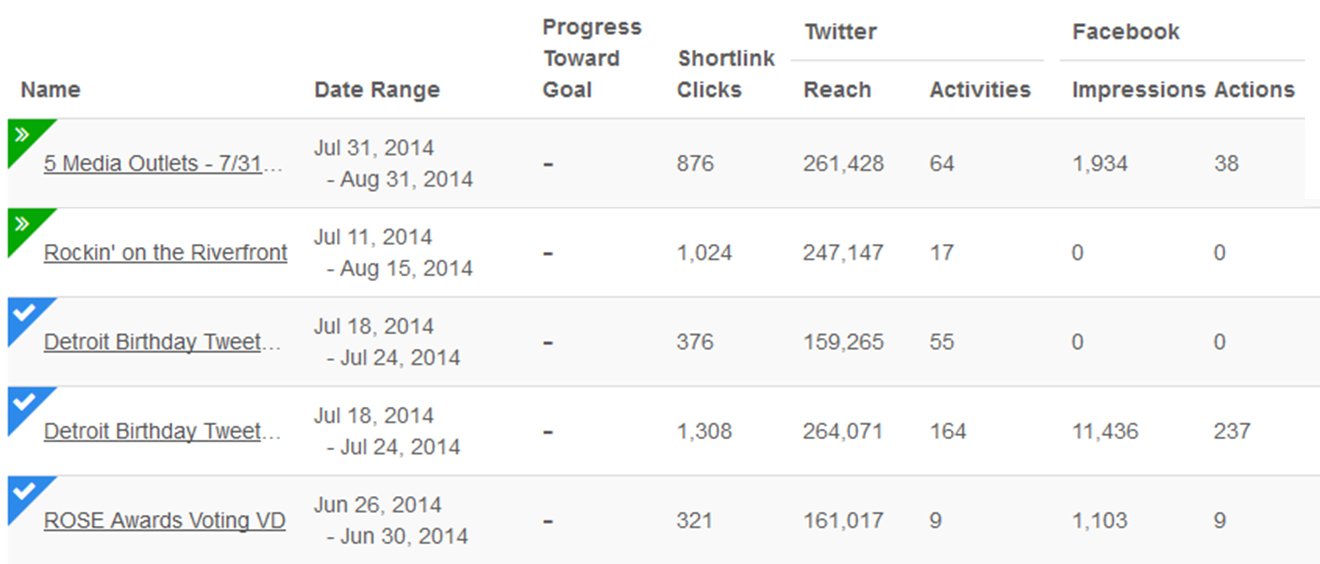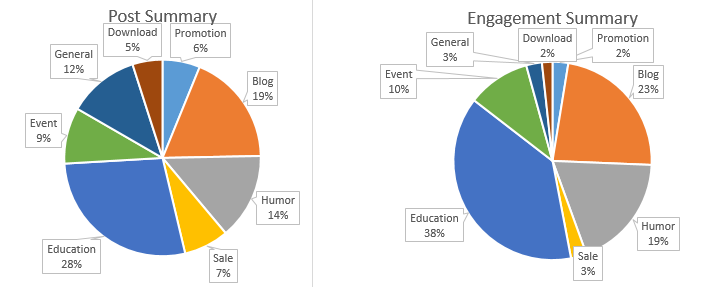How to Create Social Media Analytics that Support Your Content Strategy
 Can you analyze how your social media content strategy is working? What would you measure to see what content categories are most successful with your audience?
Can you analyze how your social media content strategy is working? What would you measure to see what content categories are most successful with your audience?
The topic of social media analytics has been covered before, but not from a content strategy standpoint. There’s a lot of resources that show you at a high level how to analyze how your posts are doing on social media. Or how to report the number of new followers and ‘likes’ you’ve received.
But how can you tie social media analytics back to your content strategy?
Create the Framework for Your Social Media Analytics
Before you can create analytics that tie back to your social media content strategy you’ll need to generate ideas for your strategy and organize them i n a content calendar. It’s useful to start with a social media calendar template to collect and organize your ideas.
n a content calendar. It’s useful to start with a social media calendar template to collect and organize your ideas.
Think carefully about how you’d like to organize and categorize your posts. For example, by topics like educational, promotional, humor, sales, blogs, tips, ebooks etc. Ask yourself how you’d like to measure what post topics are doing well.
Also, decide on your target mix for the appropriate percentage for each type of post. For example, a general rule of thumb is to target 40-50% of your posts to be educational or tips, while no more than 15% of posts should be promotional.
Spend the time up front to think strategically about the analytics you’d like to see after your posts are sent. You’ll then be able to tag posts with different categories when you create them. You won’t be left wishing later that you’d thought of it before.
What’s Wrong With Basic Analytics?
There’s nothing wrong with the basic metrics that all the social networks and social media management tools give you. In fact, you should be periodically reviewing statistics such as:
- Follower / Fan growth

- Reach and Impressions
- Engagement: likes, comments, retweets, shares, link clicks
- Audience demographics
- Post activity: how many per day, week, month
These reports provide good high level views of the health of your social activity. A drop or low value in one of these metrics could mean that you should create a strategy for improving it.
You should also take a look at the best times to post on your social networks once in a while. Adjust your posting schedule according to when your audience is most likely to be online and active. Here’s an example to figure out the best time to post on Facebook.
But these metrics don’t really give you a clear idea of how your content strategy for social media is working. It’s difficult to answers questions like:
- What types of posts get the most engagement?
- How do promotional posts compare to educational posts?
- Do posts for blog articles get more clicks than ebook download posts?
- Do curated tips get more engagement than our own tips?
- How can I improve clicks on blog posts?
In other words, basic social media analytics can help you identify general content problems, but can’t help you figure out WHAT to fix and HOW to fix them.
Only you can decide what will be the best way to analyze your social media content results. Here’s a few ways to think about and organize your posts.
- Posts to ‘keep your audience warm’
- Posts for marketing and social media campaigns
- Categories for different topics or types of posts
Remember that it can be very helpful to analyze your posts from many different angles, so don’t be afraid to experiment.
Keeping Your Audience ‘Warm’
You’ve worked hard to develop a following on your social networks, and it’s important to keep these fans ‘warm.’ If you don’t share content with them and engage to keep their attention, they’ll stop paying attention to you.
Many of your social media posts will have the goal of keeping your audience engaged and paying attention to you.
Whether you’re curating content from bloggers or news site or publishing your own original content it’s important to know which of your posts are focused on generating engagement and sharing to keep your audience warm.
Be sure to think about how you’d like to track the types of posts that are meant to keep your audience engaged. Organize posts by topic areas so you’ll be able to test which topics are most interesting. More on this later.
- Try Scheduling and Tracking Posts with Rignite
Rignite makes it easy to schedule posts for your own content or from blogs and RSS feeds while monitoring the web. You can create your own ways of tracking posts to make sure your content strategy is working.
How Are Your Social Media Marketing Campaigns Doing?
If you’re trying to grow your business you’ll be running a few marketing campaigns and promotions. Each campaign can (and probably should) result in a series of related social media posts. For example, at the beginning to announce it, in the middle, and at the end to give people a last chance to take action. A campaign can contain a few posts to dozens of posts over a few days or a few months.
It’s important to be able to analyze each campaign as a series of posts. To do this, you’ll need to create social media campaign analytics which add up the results from all posts in your campaign.
Many of the analytics are the same as discussed earlier in the basic analytics section, but instead they are shown for all of the campaign posts only. Here’s a sample snapshot from the Rignite dashboard. You can see results for the campaign by day, social network, individual post, and more.

It’s also useful to compare campaigns to each other. Comparing results from one campaign to another can give you insight into what promotions work best. Depending on your strategy, your campaign posts might be on several social networks or just on Twitter or Facebook. Either way, you can see how your campaign is doing.

If your campaign is designed to drive people to your website or registration form, the number of link clicks will be most important. If it’s to generate engagement, then the engagement activities and actions would be important. And if the goal is to generate awareness then the highest reach and impressions would be your target.
How can you calculate campaign results? You can use a tool like Rignite to schedule and analyze your social media campaigns or keep track of them manually by downloading data into a spreadsheet. You should always be looking at your campaign results to see what works and what doesn’t.
It might take more time to keep track of social media campaign analytics, but campaigns are the most important part of your marketing strategy.
Organize and Analyze Your Posts by Category for Deeper Insight
A well designed social media content strategy will have a mix of content ideas and types of content that is proven to attract the attention of your target audience. But how can you see what types of content are getting a better response? And how can you make sure you’re staying close to your targeted mix percentages? Were 40% of your posts last month promotional (too high)? Or were there not enough promotional posts?
In order to do this you’ll need to assign one or more categories to each of your posts, so you can track them. Think of these as tags, where you can assign tags to posts to help you analyze them later. What category tags should you create?
The most basic tags are categories for topics of posts such as educational, promotional, blog, humor, events, and other common posts you’ll be making.
By categorizing your posts and counting them you’ll be able to maintain your target mix. You should review your post mix percentages weekly and monthly and make adjustments as needed.
Tracking engagement by post categories as in the chart above (right) will help you see what types posts are attracting responses. The chart shows that Education posts get 38% of engagement while accounting for only 28% of the posts. That means the Education post engagement rate is much higher than that for Promotion posts, which get only 2% of engagement. Is this your expectation or do you need to make improvements to your promotional posts?
After establishing a benchmark for what to expect from your posts, you can try experiments to improve your results. Here’s some questions you might ask:
- How can I increase the engagement on Promotion posts without increasing the percentage of Promotion posts?
- Should I focus on link clicks to my website more than overall engagement for promotion posts?
- Is the engagement rate for curated Education posts higher or lower than my own content for Education posts?
- Do my posts on Facebook for women’s fashion advice get more engagement than my posts on Twitter for women’s or men’s fashion advice?
You can see that some of these questions will require you to be able to analyze posts using different categories than those shown in the charts above. The categories that you create and analyze for your posts should always tie back to your social media content strategy.
Other Uses for Categorizing Posts
Measuring results by general post topic is the main benefit of adding category tags to your posts. But here are other example uses:
- Track posts by creator’s department. If each department is required to make a certain number of posts a week, then you can track the number, percentage, and results for posts by department such as marketing, execs, sales, police, fire, power, or how ever you’re organized.
- Identify ad-supported posts. Posts which are boosted or sponsored with ad budget will have different results and should be separated from purely organic post results.
- Group posts by product category. Analyze posts by product lines such as menswear, cosmetics, furnishings and jewelry.
There’s really no right way or wrong way. It’s just very important to make sure that the metrics your choose to organize your posts relate to your content strategy.
Now Experiment and Improve Your Social Media Content
Once you have have set up your system for creating and analyzing your social media content, start experimenting.
Try looking at your posts from different angles. If you’re going to try a different style, theme or subject area for posts be sure to categorize them so you’ll be able to measure success later.
You can easily create campaigns and apply category tags to posts in Rignite. You’ll then be able to analyze your posts from any angle you find useful.
Manage Your Social Media Posts and Create Analytics in Rignite
Rignite is a social media management solution to manage all your social networks from a single console. Schedule posts and campaigns, tag posts with categories, and analyze your results. Monitor conversations and engage with fans. Promote blogs, contests, giveaways and more.

